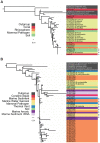From dandruff to deep-sea vents: Malassezia-like fungi are ecologically hyper-diverse
- PMID: 25144294
- PMCID: PMC4140847
- DOI: 10.1371/journal.ppat.1004277
From dandruff to deep-sea vents: Malassezia-like fungi are ecologically hyper-diverse
Conflict of interest statement
The author has declared that no competing interests exist.
Figures

References
-
- Boekhout T, Guého E, Mayser P, Velegraki A, editors (2010) Malassezia and the Skin: Science and Clinical Practive. Berlin: Springer. 1 pp. doi:10.1007/978-3-642-03616-3
Publication types
MeSH terms
LinkOut - more resources
Full Text Sources
Other Literature Sources

